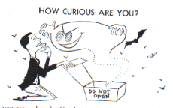Mondo DC
Octopus Gardens
by Jeff Bagato

Sunny can even "blush" better than Williams--her skin changes from red to mottled white, from smooth to bumpy to bumpier, all depending on her mood, or what she wants to tell us.
"She definitely gets more active when more people are around," National Zoo volunteer Mary Shaffner says. "She shows off."
Sunny is a Pacific Giant Octopus (enteroctopi dolfleini) from the cold waters of the Pacific Northwest, near Seattle. She's been a Washingtonian for only a few months now, living at the National Zoo's Invertebrate House, having replaced another octopus that died in January.
Every day near the hours of 11 am and 3 pm, National Zoo volunteers feed Sunny by putting a piece of cooked shrimp--or sometimes frozen blue crab or even smelt--on a stick and lowering it into the tank. When Sunny "smells" the food with special sensors on her arms, she grabs the stick with a very strong grip, pulls off the food and stuffs it into her beak.
Sunny isn't likely to show you her own beak, but if you want to see one, a nearby volunteer is likely to have one in her pocket. Octopuses are the only mollusks that have no shell, and the hardest part of their bodies is this beak, which looks like a parrot�s hooked beak and is made of the same horn-like material. Octopuses are known for being solitary animals, fond of small, tight caves, and they can squeeze their bodies through any space so long as it's large enough for that beak!
Changing skin color is Sunny's main means of communication. In the wild, she can signal other octopuses or camouflage herself from predators. Octopuses change skin color by opening and closing special pigment-bearing cells called chromatophores in their skin, and the color possibilities are endless. "We've actually had one octopus here," Museum Specialist Tamie Gray DeWitt says, "on one side of its body it must have been taking in a certain message, while with the other eye it was taking in another message, and it could actually split itself right down the middle and be dark dark red, almost a purple black on one side, and pure white on the other side."
Although Sunny often seems very outgoing, DeWitt says, "Even Sunny will get into a corner and blend into the rocks. Playing uses a lot of energy."
You shouldn't worry that Sunny�s tank is too small for such a large octopus. "If you gave the octopus a tank the size of this building and you had one little cave, a little hidey hole in the corner, it would hide in there," DeWitt says. "She feels very safe here. We've never had an octopus shoot ink here, because they don�t feel threatened."
For a relative of the clam, the octopus is a surprisingly advanced animal. For one thing, it has a very sophisticated eye, with pupils, cornea and other structures just like ours. The octopus also has an advanced brain; it's said to be as intelligent as a house cat--and maybe more so!
Right now, zoo staff are observing Sunny's behavior in an "enriched environment," according to Assistant Curator Alan Peters. This means handing Sunny objects like dog toys, conch shells, rings and acrylic tubes to test the full range of the octopus's abilities. You can see this study in action around 1 pm every weekday afternoon. When the observation study is over, volunteers will again start feeding her by hand (rather than by the stick), letting Sunny climb on their arms and "suck" on them with her suction cups! They do need to be careful to stay at the tips of her arms and stay away from Sunny's beak--octopi have a poison gland they use to liquify prey, making them easier to eat. DeWitt assures me that no volunteers have been harmed in octopus play.
You can observe the mothering behavior of the Pacific Giant Octopus at the National Aquarium in Baltimore, where three-year-old Ophelia Octopus laid thousands of eggs over a couple weeks in July. The eggs are visible as a yellowish mass of tiny globes in one corner; all you�ll see of Ophelia is a couple of her arms nearby. Although mothering behavior isn't as exciting to watch as communicating behavior, Ophelia is doing what all octopus mothers do: she has blocked herself in her cave, refusing to go out to hunt, instead spending time fanning the eggs to keep them clean and aerated. "When she laid her eggs, she stacked all the rocks in the corner," says Aquarist Jill Forsbacka. "Some of the rocks I can't even move; they weigh 75 to 80 pounds. But she moves them. Sometimes when I clean the tank I'll move a rock but she�ll move it right back to where she wants it."
Octopuses lay eggs only once, and after the eggs hatch, the mother dies
within 15 months, mostly because she has starved herself. Even though these
eggs are unfertilized--no octopuses have been bred in captivity--this reproductive
process is the same as for breeding octopuses: her appetite is repressed
and she refuses to hunt or eat. "She used to eat 10 smelt or shrimp every
day," Forsbacka says, "and now she's eating one smelt every other day.
I try to feed her every day, but she literally spits the food back at me.
She uses her funnel to squirt the food away from her."
National Zoo, Invertebrate House, 3001 Connecticut Ave., Washington, DC 202/673-4800. Open 10-6pm daily. Octopus feedings at roughly 11 am and 3 pm. Play observation study at 1 pm.
National Aquarium in Baltimore, Pier 3, 501 E. Pratt St. 410/481-7328. Open 9-8 daily. Cost: $16 adults; seniors $13, ages 3-11 $9.50, under 3 free. www.aqua.org
[A version of this article appeared in The Washington Post,
Weekend section, Oct 5, 2001]





